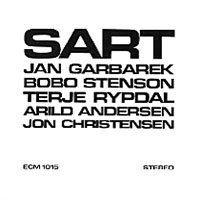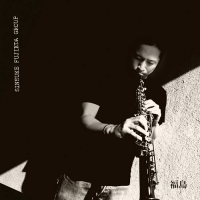Home » Jazz Articles » Extended Analysis » Jan Garbarek: Dansere
Jan Garbarek: Dansere
As much as Dansere traces Garbarek's rapid evolution from the greater extremes of free improvisation to a more form-based approach that would become the foundation of much of his life's work ever since, the three-disc box also documents the emergence of ECM's voice as a label. While label head/producer Manfred Eicher's initial goal with the label—to produce recordings of improvisation-based music (jazz, in the broadest possible definition of the term) with the clarity and transparency of classical recordings—was realized early on with recordings like pianist Marion Brown's Afternoon of a Georgia Faun (1970) and Robin Kenyatta's Girl From Martinique (1970), it was in the ensuing decade that the often-used (and often misunderstood) term "The ECM Sound" came into being. If each of the three recordings that comprise the Dansere box couldn't be more different from one another, there remains a common underlying thread that connects them, and which goes beyond the obvious participation of three musicians—Garbarek, Stenson and Norwegian drummer Jon Christensen—and engineer Jan Erik Kongshaug on all three discs.
For those familiar with the breadth and depth of a catalog that now numbers over 1,200, whitewashing attempts to pigeonhole the label's "sound" in reductionist terms—whether it be actual sound, style or presentation—simply don't make sense. But what does emerge, listening to all three recordings here, is the clear sense of a label whose interest was in creating—whether occupying the unfettered and, at times, positively electric space of Sart or the more intrinsically lyrical and entirely acoustic bent of Dansere—a relaxed and fully transparent context in the studio, one where the musicians could hear absolutely everything going on about them. A small detail, perhaps, that many would consider a given—though it is not the case, more often than might be expected—but one that provides musicians the freedom to allow notes to decay to their inevitable conclusion, resulting in more space and, ultimately, music that breathes, even at its most extreme.
And there are plenty of extremes on Sart. While Garbarek had, by this time, begun moving away from the early influences of latter-day John Coltrane and Albert Ayler—touchstones that ran deep on Til Vigdis (NJF, 1967), particularly on the incendiary live version of Coltrane's "Mr. P.C." that takes up the first side of this almost impossible-to-get debut recording, as well as on his first ECM date, 1971's Afric Pepperbird—there are still vestigial signs, especially on the saxophonist's "Irr." The piece begins with Andersen, a cappella, already demonstrating the bassist's lithe dexterity and in-the-gut tone, but gradually morphs into a fiery free-for-all quartet workout, where both Garbarek and Stenson solo with a kind of reckless abandon rarely heard subsequently. And if Rypdal sits out on "Irr," he's absolutely essential on the 14-minute title track, his wah-wah electric guitar linking the album to the more ethereal side of Miles Davis' electric music of the time, but without the jungle density that so defined the trumpeter's early '70s work. Instead, the dynamics ebb and flow organically, with Christensen's pulse oftentimes more implicit, though he does settle into a free-flowing semblance of a groove here and there, bolstering Garbarek's similarly dynamic playing, as the saxophonist moves from quiet melody to piercing, cathartic screams.
 If Sart is more about color and expression across its 42 minute duration and all-original set list—with Garbarek contributing four of its six tunes, one from Andersen (the bassist's dark but wryly titled, arco-driven duo with Garbarek, "Close Enough For Jazz") and one from Rypdal (his spacious, rumbling, solo electric guitar closer, "Lontano"), then Witchi-Tai-To reflects a number of about-faces. First, this debut from the Jan Garbarek-Bobo Stenson Quartet has no original music other than newcomer bassist Palle Danielsson's gently swinging, folk-informed "Kukka," though its selection of four tunes from three Americans and one Cuban could not be more eclectic. Entirely acoustic, while there's plenty of space for the quartet to extrapolate—in particular on Don Cherry's 20-minute "Desireless," which was but a mere 82 seconds on the trumpeter's Relativity Suite (JCOA, 1973), and whose spirit looms large over Witchi-Tai-To in its entirety—the music is, nevertheless, considerably more structured.
If Sart is more about color and expression across its 42 minute duration and all-original set list—with Garbarek contributing four of its six tunes, one from Andersen (the bassist's dark but wryly titled, arco-driven duo with Garbarek, "Close Enough For Jazz") and one from Rypdal (his spacious, rumbling, solo electric guitar closer, "Lontano"), then Witchi-Tai-To reflects a number of about-faces. First, this debut from the Jan Garbarek-Bobo Stenson Quartet has no original music other than newcomer bassist Palle Danielsson's gently swinging, folk-informed "Kukka," though its selection of four tunes from three Americans and one Cuban could not be more eclectic. Entirely acoustic, while there's plenty of space for the quartet to extrapolate—in particular on Don Cherry's 20-minute "Desireless," which was but a mere 82 seconds on the trumpeter's Relativity Suite (JCOA, 1973), and whose spirit looms large over Witchi-Tai-To in its entirety—the music is, nevertheless, considerably more structured. Carla Bley's droning "A.I.R. (All India Radio)"—first heard on the pianist's ambitious collaboration with lyricist Paul Haines, Escalator Over the Hill (JCOA, 1971), and, again, considerably expanded here from its original length to allow for plentiful soloing—is driven by Danielsson's two-chord ostinato and Christensen's loosely flowing pulse. If Garbarek's attention to the purity of each and every note was an early cornerstone, it emerges here, finally fully formed, with a timbre on both tenor and curved soprano that is instantly recognizable, regardless of context. If Stenson has since become known for his restraint and unfailing lyricism, here in this modal context he demonstrates a relatively early virtuosity that underscores even his sparest of subsequent work. The rubato intro to Carlos Puebla's declaration to Che Guevara, "Hasta Siempre," may reference an approach taken by Coltrane with his famous '60s quartet, but Garbarek's move towards a sparer approach, imbued with his own emerging melodicism, is another indication of subsuming influences more fully into his own now-distinct voice.
Witchi-Tai-To also bears comparison to Keith Jarrett's then-nascent European Quartet with Garbarek, Danielsson and Christensen, which released Belonging on ECM later that year, and whose archival live set, Sleeper—Tokyo, April 16, 1979 (2012), has also just been issued by the label. Beyond the obvious difference of Jarrett's leadership versus the more egalitarian Garbarek-Stenson group, despite the largely American content of Witchi-Tai-To, and acknowledging the unmistakable Scandinavian influence that Garbarek, Danielsson and Christensen brought to Jarrett's music—while, at the same time, reflecting their undeniable American tradition cred, having supported a number of American artists touring their countries in the late 1960s/early 1970s—it's remarkable just how different these two recordings are.
 Stenson may not have become the jazz giant that Jarrett has—though how much of that has to do with Jarrett's already significant name through his work with Miles Davis and Charles Lloyd (and the irony is not lost when, returning to regular activity in 1989 and beginning a relationship with ECM that continues to this day, the American saxophonist recorded 1990's Fish Out of Water with Danielsson, Christensen...and Stenson) and the undeniable fact of his being American garnering him more immediate acceptance in his own country—but there's no denying his own prominence, influence, and irrefutable place in jazz history for the latter quarter of the 20th century into the new millennium. If his own ECM trio debut, 1971's Underwear, has become a largely overlooked gem—only released on CD in a limited Japanese edition, though it's now available in digital download form—there's no doubt that Witchi-Tai-To was the album the brought Stenson, along with Garbarek, Danielsson and Christensen, to greater and much-deserved international acclaim.
Stenson may not have become the jazz giant that Jarrett has—though how much of that has to do with Jarrett's already significant name through his work with Miles Davis and Charles Lloyd (and the irony is not lost when, returning to regular activity in 1989 and beginning a relationship with ECM that continues to this day, the American saxophonist recorded 1990's Fish Out of Water with Danielsson, Christensen...and Stenson) and the undeniable fact of his being American garnering him more immediate acceptance in his own country—but there's no denying his own prominence, influence, and irrefutable place in jazz history for the latter quarter of the 20th century into the new millennium. If his own ECM trio debut, 1971's Underwear, has become a largely overlooked gem—only released on CD in a limited Japanese edition, though it's now available in digital download form—there's no doubt that Witchi-Tai-To was the album the brought Stenson, along with Garbarek, Danielsson and Christensen, to greater and much-deserved international acclaim. That Stenson is not a particularly prolific composer may also have something to do with his status, when compared to Jarrett (at least, at that time, since the American pianist has long since deserted formal composition). With the release of Dansere in 1976, the group was still called the Jan Garbarek-Bobo Stenson Quartet, but as it turned to all-original music, it was the saxophonist who contributed all but one of its six pieces. Even the sole non-Garbarek composition, "Lokk," was arranged by the saxophonist, based on a theme by Norwegian folk musician Thorvald Tronsgård (1892-1986). While, perhaps, the most direct indicator, it was ultimately just one sign on Dansere that Garbarek was intent on bringing Norwegian traditionalism into his music, a decision that has colored his career ever since.
 As Michael Tucker—author of the definitive Garbarek biography, Deep Song (EastNote, 1998)—clarifies in the equally superb essay that accompanies the Dansere box, it was with Dansere, the album, that Garbarek crystallized a sound that can only be described as Nordic, and which would be a fundamental part of subsequent recordings, ranging from his wind harp-driven duet recording with guitarist Ralph Towner, Dis (1977), through to the more pulse-driven (and, for some, the nail on the coffin of his departure from what they deem to be jazz) Legend of the Seven Dreams (1988) and I Took Up the Runes (1990).
As Michael Tucker—author of the definitive Garbarek biography, Deep Song (EastNote, 1998)—clarifies in the equally superb essay that accompanies the Dansere box, it was with Dansere, the album, that Garbarek crystallized a sound that can only be described as Nordic, and which would be a fundamental part of subsequent recordings, ranging from his wind harp-driven duet recording with guitarist Ralph Towner, Dis (1977), through to the more pulse-driven (and, for some, the nail on the coffin of his departure from what they deem to be jazz) Legend of the Seven Dreams (1988) and I Took Up the Runes (1990). "Skrik & Hyl (Cries and Confusion)," a duo featuring Danielsson's upper-register arco and Garbarek's tenor, may only last a mere 94 seconds and act more as an introduction to "Lokk," but its evocation of windswept landscapes and white-capped waters is as provocative as Garbarek's use of a folk musician's theme based on a cattle call in announcing a directional shift with Dansere. If Garbarek still managed to throw in a few visceral screams on Witchi-Tai-To—and they appear here, as well, but this time with a stronger sense of careful intent—by Dansere, his pursuit of tonal perfection with every note became even more definitive, as did an even greater allegiance to space. The 15-minute title track that opens the album unfolds with tremendous (and effective) patience, and Garbarek's solo, beginning halfway into the tune (and only a mere 80 seconds after both the composition's time and theme have finally emerged), develops with similar composure and control—a far cry from the abandon of Sart and what came before. Stenson, too, seems to focus more finely on the concept of development, while Danielsson and Christensen, if not exactly relegated to rhythm section status (neither musician ever straightjacketed to that extent), certainly adhere more to a concept of groove, and with greater nuance than ever before.
If an unmistakably Scandinavian approach to playing rubato—something Garbarek's Sart cohort, Terje Rypdal, was also investigating, but from a very different angle, on Odyssey—can be found on earlier Garbarek records, it's on Dansere that the saxophonist finally honed it to perfection, lending the intro to "Bris" such a sense of suspension that, when the quartet coalesces halfway in, there's a palpable sense of release, even as Garbarek delivers one of his most soaring solos of the set, bolstered by Danielsson's round tone and Christensen's ever-shifting approach to time. Dansere's title track is the one most often cited, but the shorter "Bris" may actually possess some of the album's strongest moments, with Stenson also turning in an early career-defining performance.
More than forty years after the release of Sart, the release of the Old & New Masters Edition Dansere box concisely documents a time when ECM and its artists were pushing the boundaries of what the word "jazz" meant. Arguments will, no doubt, continue to be had about whether the label has proven to be its savior, its antichrist or simply a forward-thinking participant in its evolutionary history, but what is impossible to deny is the innovation that was taking place as the label looked increasingly farther afield, recruiting musicians from cultures around the world to incorporate their own traditions within a broader inclusionary definition.
Dansere represents a time when this particular group of musicians was acknowledging the undeniable influence of the American jazz tradition on their musical development, while just as fervently declaring that their own culture was an equal participant in the shaping of definitive voices whose influence continues to be felt on subsequent generations—and, most significantly, beyond their own borders. That there are American jazz musicians who now cite Garbarek, Stenson, Danielsson, Christensen, Rypdal and Andersen as seminal influences on their development only speaks to the wonderful cross-pollination that defines not just jazz, but all music. It makes the release of Dansere all the more significant, then, as an indicator that the evolution of music is never a one-way street, and that as much as the American tradition continues to be felt in countries abroad, the music it has engendered in those far-away places is now coming home to roost in the land where jazz began...and that's exactly as it should be.
Tracks: CD1 (Sart): Sart; Fountain Of Tears—Part I and II; Song Of Space; Close Enough For Jazz; Irr; Lontano. CD2 (Witchi-Tai-To): A.I.R.; Kukka; Hasta Siempre; Witchi-Tai-To; Desireless. CD3 (Dansere): Dansere; Svevende; Bris; Skrik & Hyl; Lokk (Etter Thorvald Tronsgard); Til Vennene.
Personnel: Jan Garbarek: tenor and soprano saxophones, flute (CD1); Bobo Stenson: piano, electric piano (CD1); Jon Christensen: percussion (CD1), drums (CD2, CD3); Terje Rypdal: guitar (CD1); Arild Andersen: double bass (CD1); Palle Danielsson: double bass (CD2, CD3).
Track Listing
CD1 (Sart): Sart; Fountain Of Tears - Part I and II; Song Of Space; Close Enough For Jazz; Irr; Lontano. CD2 (Witchi-Tai-To): A.I.R.; Kukka; Hasta Siempre; Witchi-Tai-To; Desireless. CD3 (Dansere): Dansere; Svevende; Bris; Skrik & Hyl; Lokk (Etter Thorvald Tronsgard); Til Vennene.
Personnel
Jan Garbarek
saxophoneJan Garbarek: tenor and soprano saxophones, flute (CD1); Bobo Stenson: piano, electric piano (CD1); Jon Christensen: percussion (CD1), drums (CD2, CD3); Terje Rypdal: guitar (CD1); Arild Andersen: double bass (CD1); Palle Danielsson: double bass (CD2, CD3).
Album information
Title: Dansere | Year Released: 2012 | Record Label: ECM Records
Tags
PREVIOUS / NEXT
Support All About Jazz
 All About Jazz has been a pillar of jazz since 1995, championing it as an art form and, more importantly, supporting the musicians who make it. Our enduring commitment has made "AAJ" one of the most culturally important websites of its kind, read by hundreds of thousands of fans, musicians and industry figures every month.
All About Jazz has been a pillar of jazz since 1995, championing it as an art form and, more importantly, supporting the musicians who make it. Our enduring commitment has made "AAJ" one of the most culturally important websites of its kind, read by hundreds of thousands of fans, musicians and industry figures every month.





















